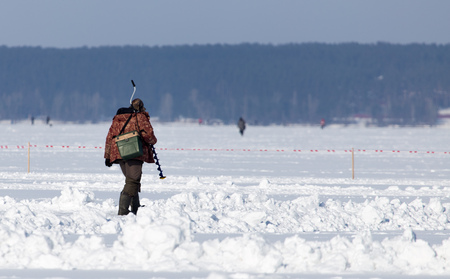1. Introduction to Ice Fishing in India
Ice fishing, a unique angling experience typically associated with cold regions like Canada and Scandinavia, is now making its entry into the Himalayan belt of India. In recent years, states such as Jammu & Kashmir, Himachal Pradesh, and Uttarakhand have witnessed the rise of ice fishing activities during their winter months. This new adventure has started to blend seamlessly with the local rural traditions, offering both residents and travellers a fresh perspective on winter tourism. For centuries, these mountain communities have relied on rivers and lakes for sustenance, using traditional fishing techniques passed down through generations. Now, with the advent of ice fishing, locals are adapting their age-old practices to frozen waters, turning once quiet winters into seasons bustling with activity. The pristine natural landscape – snow-capped peaks, crystal-clear frozen lakes, and serene valleys – provides an enchanting backdrop for this sport. More than just a hobby, ice fishing in India is emerging as a bridge between modern adventure seekers and the rustic charm of rural Himalayan life.
2. Cultural Significance and Local Traditions
Ice fishing, though a relatively new adventure activity in India, has quickly woven itself into the cultural fabric of Himalayan and northern mountain communities. The practice is not just about catching fish through frozen surfaces; it reflects the deep connection locals have with their environment and age-old survival techniques. For many indigenous groups like the Ladakhis and Himachalis, adapting to harsh winters means utilizing every resource available—including rivers and lakes that freeze over. In these regions, ice fishing is not only an economic opportunity but also a social event where stories are exchanged, traditional songs are sung, and families gather around makeshift shelters on the ice.
Blending Modern Tourism with Ancestral Wisdom
As rural tourism grows in India, visitors are invited to learn from local experts who possess generations of knowledge about weather patterns, fish migration, and safe practices on ice. This sharing of wisdom bridges cultures and ensures sustainable tourism. The mutual respect between tourists and hosts helps preserve both natural habitats and intangible heritage.
Indigenous Knowledge vs. Modern Techniques
| Aspect | Traditional Approach | Modern Influence |
|---|---|---|
| Fishing Methods | Hand-crafted wooden rods, bait made from local plants | Imported gear, artificial lures |
| Weather Prediction | Elderly observations, sky patterns, animal behavior | Meteorological apps, digital thermometers |
| Community Gathering | Festivals, storytelling circles on ice | Guided tours, group competitions |
| Sustainability Practices | Catching only what’s needed for food | Catch-and-release policies for tourists |
Lifestyle Integration in Mountain Villages
The rhythm of life in India’s coldest districts revolves around the seasons. During winter months when roads close due to heavy snowfall, ice fishing becomes both recreation and necessity. Women often prepare hot chai and snacks for those out on the frozen lakes while children play nearby. Such scenes illustrate how rural tourism can offer outsiders a genuine taste of Himalayan hospitality—rooted in resilience and community spirit. In this way, ice fishing transforms into a unique bridge connecting the ancient with the contemporary, enriching both local livelihoods and tourist experiences.

3. Opportunities for Rural Tourism
Ice fishing is not just a unique adventure activity but also a catalyst for rural tourism, especially in states like Jammu & Kashmir, Himachal Pradesh, and Uttarakhand. These regions are blessed with pristine lakes and rivers that freeze during winter, presenting perfect conditions for ice fishing. By promoting this activity, local communities can attract both domestic and international tourists seeking offbeat experiences.
The development of ice fishing as a tourism product offers new livelihood options for villagers. Local youth can be trained as guides or instructors, sharing their traditional knowledge of the region’s waters and fish species. Homestays and small guesthouses can flourish as tourists seek authentic Himalayan hospitality. Artisans may find a market for handcrafted fishing gear and souvenirs inspired by local culture.
Moreover, ice fishing festivals can be organised, blending adventure with the rich cultural tapestry of these states. Visitors can enjoy folk music, traditional cuisine, and local art alongside their angling adventures. This holistic experience not only boosts the rural economy but also helps preserve cultural heritage and promotes environmental awareness among travellers.
In short, embracing ice fishing as part of rural tourism opens doors to sustainable income, skill development, and the revitalisation of remote Himalayan communities—all while offering travellers a slice of India rarely seen before.
4. Ice Fishing: Technique and Experience
For many Indians, ice fishing is a new frontier in the world of angling, blending adventure with traditional rural tourism. As this activity finds its place in regions like Ladakh, Himachal Pradesh, and Uttarakhand, more local enthusiasts are stepping onto frozen lakes to try their luck. Let’s break down the practical know-how for beginners, the essential gears needed, and share some first-hand experiences from Indian anglers.
Essential Ice Fishing Techniques
Ice fishing in India requires patience and an understanding of unique techniques suited to sub-zero conditions. Here are the basic steps:
- Drilling the Hole: Use a manual or powered auger to create a small hole (usually 6-8 inches wide) on the ice surface.
- Baiting and Setting the Line: Attach natural baits like worms or artificial lures to your hook. Lower your line slowly through the hole until it reaches just above the lakebed.
- Jigging: Gently move your rod tip up and down to attract fish. This mimics the movement of prey beneath the ice.
- Patience Pays Off: Wait for subtle bites—fish are less active in cold water, so gentle tugs may be all you feel.
Must-Have Gears for Indian Ice Fishing
| Item | Description | Local Tips |
|---|---|---|
| Ice Auger | Manual or electric drill for making holes in thick ice. | Coffee can lids or heated rods can work as makeshift tools if augers aren’t available. |
| Short Rod & Reel | Compact rods (24–36 inches) designed for limited space fishing. | A short bamboo stick with a basic reel works well for beginners on a budget. |
| Bait/Lures | Maggots, worms, or small spoons/jigs that attract trout and snow carp. | Locally-sourced earthworms are effective and budget-friendly. |
| Warm Clothing | Thermal wear, gloves, boots, windproof jackets to stay warm. | Layering with traditional woollen shawls (pashmina) keeps body heat intact. |
| Shelter/Mat | A simple tent or insulated mat for sitting on the ice. | An old tarpaulin sheet or gunny bags add comfort and insulation. |
Voices from Indian Anglers: Real Experiences
“The thrill of waiting in silence over Pangong Tso Lake as tiny ripples appear on my line is unmatched,” says Sonam Dorje from Leh. “With every catch, I feel more connected to my roots.”
Anil Kumar from Manali shares: “We used leftover mutton fat as bait once. The trout loved it! My friends and I celebrated our first catch with hot chai on the ice.”
Quick Tips for Beginners
- Safety First: Always check ice thickness (at least 10 cm) before venturing out. Travel with locals who know the area well.
- Cultural Etiquette: Respect local customs—seek permission if fishing near villages or sacred water bodies.
- Sustainable Practice: Release undersized fish back into the water to keep fish populations healthy for future generations.
Your First Catch Awaits!
Dive into this blend of chilly adventure and rural hospitality—ice fishing in India offers not just fish, but stories, friendships, and a slice of Himalayan life you won’t forget.
5. Challenges and Sustainability Concerns
As ice fishing and rural tourism are gaining popularity in India’s northern mountain regions, several challenges and sustainability concerns have come to the forefront.
Environmental Impacts
The fragile Himalayan and high-altitude ecosystems are particularly vulnerable to increased tourist activity. Ice fishing, if not managed responsibly, can lead to disturbances in aquatic life, water pollution from improper waste disposal, and habitat degradation. The use of non-biodegradable materials and unregulated foot traffic on frozen lakes can accelerate ecological damage. It is crucial to adopt eco-friendly practices, such as mandating the use of biodegradable gear and strict waste management protocols, to minimize the footprint on these pristine environments.
Safety Risks for Tourists
India’s ice fishing destinations often lack established safety infrastructure compared to international locations. Inexperienced tourists may underestimate the dangers posed by thin ice, sudden weather changes, or unfamiliarity with local terrain. There have been instances where inadequate safety measures resulted in accidents or health emergencies due to extreme cold. Training local guides, providing basic rescue equipment, and educating visitors about ice safety are essential steps towards reducing risks.
The Need for Sustainable Tourism Practices
With increasing interest in rural tourism, it is important for both government authorities and private operators to work together on sustainable development plans.
Community Involvement
Empowering local communities to manage tourism activities ensures that economic benefits stay within the village while fostering a sense of stewardship over natural resources. Initiatives like homestays and community-based tourism models have shown positive results in regions such as Uttarakhand and Himachal Pradesh.
Regulatory Frameworks
The absence of clear regulations can lead to overexploitation and environmental stress. Setting up guidelines for visitor numbers, fishing quotas, seasonal restrictions, and mandatory environmental impact assessments will help balance economic growth with ecosystem protection.
Towards a Balanced Future
If India wants its rural tourism sector—especially niche segments like ice fishing—to thrive without jeopardizing sensitive landscapes, adopting a proactive approach towards sustainability is non-negotiable. By addressing these challenges head-on, India can position itself as a responsible adventure destination where nature, culture, and livelihoods flourish together.
6. Way Forward: Boosting Rural Economy and Promoting Atithi Devo Bhava
As India explores the potential of ice fishing and rural tourism, it is essential to consider sustainable pathways that benefit both travellers and local communities. The future of this niche lies in responsible tourism practices, strong partnerships with villagers, and the embodiment of the Indian ethos—Atithi Devo Bhava, or “Guest is God.”
Encouraging Responsible Tourism Initiatives
To preserve the pristine beauty of India’s northern states and their frozen lakes, tourism operators must adopt eco-friendly methods. Organising guided tours that respect local wildlife, promoting ‘leave no trace’ principles, and educating tourists about fragile ecosystems are crucial steps. Waste management facilities, use of biodegradable products, and strict adherence to government guidelines can ensure that the environment remains unspoiled for generations.
Forging Partnerships with Local Communities
The heart of rural tourism is community involvement. By partnering with local Panchayats and Self-Help Groups (SHGs), tourism businesses can create employment opportunities for villagers as guides, cooks, homestay hosts, or craft sellers. These collaborations not only empower the community but also provide tourists with authentic experiences—from traditional Kashmiri Kahwa around a bonfire to folk music performances on frozen lakeshores.
Promoting Atithi Devo Bhava: Guest is God
India’s centuries-old tradition of Atithi Devo Bhava should be at the core of every rural tourism initiative. Training locals in hospitality skills, language basics, and first aid will help them welcome guests warmly and safely. Tourists, in turn, should be encouraged to respect local customs—removing shoes before entering homes, participating in cultural rituals, or enjoying home-cooked meals with gratitude. This mutual respect fosters cross-cultural understanding and transforms a simple fishing trip into an unforgettable memory.
Conclusion: A Win-Win Opportunity
If planned thoughtfully, ice fishing and rural tourism can boost rural economies while preserving nature and culture. By embracing sustainability, collaboration, and the spirit of Atithi Devo Bhava, India can set an example for responsible adventure tourism worldwide—where guests arrive as visitors but leave as family.


